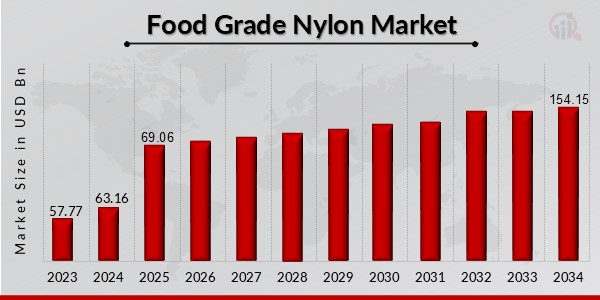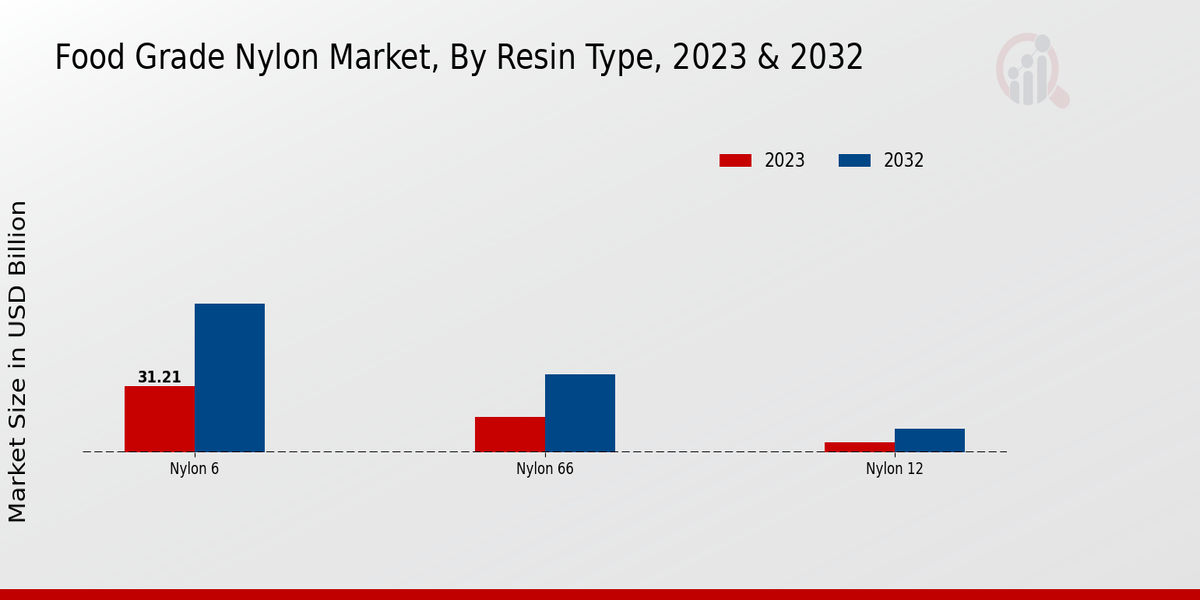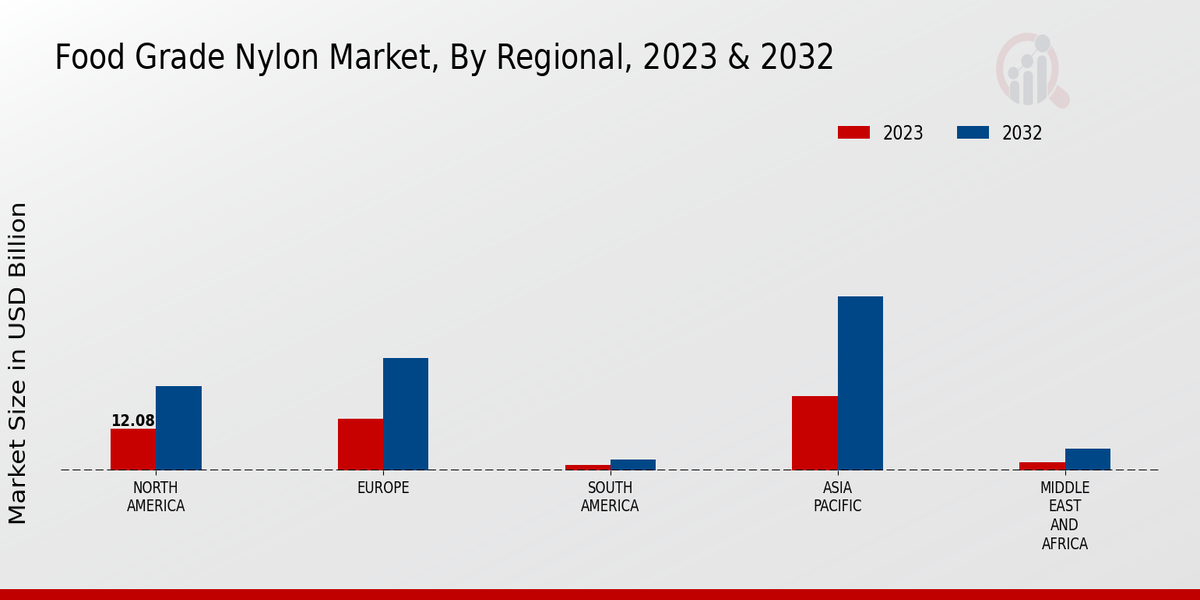Global Food Grade Nylon Market Overview
Food Grade Nylon Market Size was estimated at 63.16 (USD Billion) in 2024. The Food Grade Nylon Industry is expected to grow from 69.06 (USD Billion) in 2025 to 154.15 (USD Billion) by 2034. The Food Grade Nylon Market CAGR (growth rate) is expected to be around 9.3% during the forecast period (2025 - 2034).

Source: Primary Research, Secondary Research, Market Research Future Database and Analyst Review
Key Food Grade Nylon Market Trends Highlighted
Key market drivers for the food-grade nylon market include rising demand for lightweight, durable, and chemically resistant products in the packaging and food processing industries. Strict regulations and consumer awareness concerning food safety are fueling the adoption of food-grade nylon in food contact applications. Furthermore, advancements in nylon resin technology, such as the development of high-performance materials with enhanced barrier properties, are creating new opportunities for market growth.
Opportunities to be explored or captured in the food-grade nylon market lie in expanding into emerging economies with growing food and beverage sectors. The increasing demand for sustainable packaging solutions presents opportunities for innovative bio-based and biodegradable food-grade nylon materials. Additionally, the development of transparent food-grade nylon with improved visual aesthetics can open new avenues for product differentiation and value creation.
Recent trends in the food-grade nylon market include the adoption of high-barrier packaging materials to extend product shelf life and reduce food waste. The increasing use of nylon in retort pouches for ready-to-eat meals and beverages is driving market growth. Furthermore, there is a growing focus on sustainable practices, which is leading manufacturers to develop food-grade nylon solutions that are recyclable or compostable.
Food Grade Nylon Market Drivers
Increasing Demand for Flexible Packaging
The growing demand for flexible packaging is a major driver of the Food Grade Nylon Market Industry. Flexible packaging solutions offer numerous advantages, including lightweight, durability, cost-effectiveness, and sustainability. Food-grade nylon films are widely used in flexible packaging applications due to their excellent barrier properties, which help preserve the freshness and quality of food products. The increasing adoption of flexible packaging in various food industries, such as snacks, confectionery, and processed foods, is expected to drive the demand for food-grade nylon.
Rising Consumer Preference for Convenient Food Options
Another driver for the Food Grade Nylon Market Industry, is the preference of consumers for convenient food. Due to the rising trend of ready-to-eat meals, snacks and meals on the go, greater has the demand for packaging materials that will keep the food fresh and of good quality. Food grade nylon films are perfect for such purposes, as they demonstrate great barrier properties against gases and moisture and do not get damaged during transportation and storage.
Stricter Food Safety Regulations
Also, stringent food safety regulations imposed by government agencies all over the world are generating demand for food grade nylon. Food safety regulations are generally imposed with the view to ensuring that the food products are safe as well as of good quality. Moreover, many such regulations specify the type of materials that should be used for packaging to ensure their safe quality. Furthermore, demand for nylon as a packaging material is also increasing as food grade nylon films or bags comply with food safety regulations and provide a safe packaging material for packaging.
Food Grade Nylon Market Segment Insights:
Food Grade Nylon Market Resin Type Insights
The Food Grade Nylon Market segmentation by Resin Type includes Nylon 6, Nylon 66, and Nylon 12. Nylon 6 is the most widely used type of food grade nylon, accounting for over 50% of the global market share in 2023. It is known for its excellent mechanical properties, such as high strength, stiffness, and toughness, making it suitable for a wide range of food packaging applications. Nylon 66 is another commonly used type of food grade nylon, with a market share of around 30% in 2023.
It offers higher temperature resistance and chemical resistance compared to Nylon 6, making it ideal for applications such as cooking utensils and food processing equipment.Nylon 12, with a market share of around 20% in 2023, is a specialty type of food grade nylon that is characterized by its low friction coefficient and high abrasion resistance. It is often used in food packaging applications where these properties are crucial. The demand for food grade nylon is expected to grow at a steady pace in the coming years, driven by the increasing demand for safe and reliable food packaging solutions.
The growth of the food grade nylon market can be attributed to the rising demand for packaged food products, the increasing awareness of food safety, and the growing adoption of sustainable packaging solutions.

Source: Primary Research, Secondary Research, Market Research Future Database and Analyst Review
Food Grade Nylon Market Application Insights
The application segment of the Food Grade Nylon Market comprises various segments such as Food Processing Equipment, Food Packaging, and Beverage Processing Equipment. Among these, Food Processing Equipment held the largest share of the market in 2023, owing to the extensive use of nylon in the production of food processing machinery, such as conveyors, mixers, and molding equipment. It offers excellent properties like high strength, wear resistance, and corrosion resistance, making it suitable for demanding food processing applications.
Additionally, the growing demand for processed foods and beverages is driving the growth of this segment.The Food Packaging segment is expected to witness significant growth in the coming years due to the rising demand for flexible and durable packaging solutions. Nylon's barrier properties and ability to withstand a wide range of temperatures make it an ideal choice for packaging food products, extending their shelf life and maintaining their quality. Beverage Processing Equipment is another important segment, driven by the increasing consumption of bottled beverages and the need for efficient and hygienic processing equipment.
Nylon's chemical resistance and ability to handle high-pressure environments make it a preferred material for beverage processing machinery, including bottling lines and canning equipment.The expanding beverage industry is expected to contribute to the growth of this segment in the future.
Food Grade Nylon Market End-use Industry Insights
The End-use Industry segment is a crucial aspect of the Food Grade Nylon Market segmentation. Among the key sub-segments, 'Food and Beverage' held the largest market share in 2023, with a significant revenue contribution. The 'Dairy' sub-segment is projected to exhibit a promising growth trajectory, driven by increasing demand for food-grade nylon in dairy processing equipment and packaging solutions.
The 'Meat Processing' sub-segment is expected to witness steady growth, owing to the adoption of food-grade nylon in meat processing machinery and packaging materials.These sub-segments are expected to remain key contributors to the overall Food Grade Nylon Market growth, shaping its competitive landscape and future outlook.
Food Grade Nylon Market Additives Insights
The Additives segment of the Food Grade Nylon Market is anticipated to grow significantly over the forecast period. Antioxidants, flame retardants, and colorants are the key additives used in food-grade nylon to enhance its properties and meet specific requirements. The demand for antioxidants is driven by the need to protect food-grade nylon from degradation caused by exposure to heat, light, and oxygen.
Flame retardants are incorporated to improve the fire resistance of food-grade nylon, while colorants are used to impart desired colors to the material.The Food Grade Nylon Market revenue from the Additives segment is projected to reach USD 1.5 billion by 2024, exhibiting a steady growth rate. The increasing adoption of food-grade nylon in various applications, such as food packaging, kitchenware, and medical devices, is expected to fuel the demand for additives in the coming years.
Food Grade Nylon Market Distribution Channel Insights
The Food Grade Nylon Market segmentation by Distribution Channel includes Direct Sales, Distributors, and Online Platforms. Among these, Direct Sales is expected to dominate the market in 2023, accounting for over 55% of the Food Grade Nylon Market revenue. This dominance is primarily driven by the preference of manufacturers to maintain direct control over distribution, ensuring quality and timely delivery to customers.
Distributors hold a significant market share, catering to regional and local markets and providing value-added services such as storage, logistics, and technical support.Online Platforms are gaining traction, particularly for smaller-scale purchases and niche products, offering convenience, price transparency, and access to a wider customer base. These channels are expected to witness steady growth in the coming years, driven by increasing e-commerce penetration and evolving consumer buying patterns.
Food Grade Nylon Market Regional Insights
The Food Grade Nylon Market is segmented into North America, Europe, APAC, South America, and MEA. Among these regions, APAC is expected to hold the largest market share in 2023, with a market valuation of USD 22.31 Billion. This dominance is attributed to the region's rapidly growing food and beverage industry, coupled with increasing consumer awareness regarding food safety and hygiene. Europe is projected to follow APAC, with a market valuation of USD 15.67 Billion in 2023.
Stringent government regulations pertaining to food safety and the presence of a well-established food processing industry are key factors driving growth in this region.North America is also a significant market for food-grade nylon, with a market valuation of USD 12.45 Billion in 2023. The region benefits from the presence of large food and beverage manufacturers and a high demand for packaged food products. South America and MEA are expected to witness steady growth in the coming years, owing to the expanding food processing sector and rising disposable incomes.

Source: Primary Research, Secondary Research, Market Research Future Database and Analyst Review
Food Grade Nylon Market Key Players And Competitive Insights:
Companies producing food grade nylon have been making significant investments in research and development. The investments are intended at improving the quality and performance of the products. Companies producing food grade nylon are also increasingly focusing on expanding their market presence by opening new production facilities and establishing new distribution networks. The primary driver of food grade nylon market growth is the rising demand for food-grade packaging materials. On the other hand, the competitive context of the food grade nylon market is a combination of a fragmented structure and a few major global suppliers.
The presence of numerous small- and medium-sized producers in the food grade nylon market is characteristic. At the same time, in any industry, there would be a few major producers who supply the major part of the market. One of the major suppliers of food grade nylon is BASF. BASF is a German company, one of the largest manufacturers of chemicals and plastics. The company has facilities for manufacturing food grade nylon in Europe, Asia, and America. BASF also supplies raw materials to other manufacturers in the food grade nylon market. Another major company producing food grade nylon is DSM.
DSM is a Dutch company. The company has production facilities for food grade nylon in Europe and Asia and is expanding to the Americas. DSM, too, is conducting supplies of raw materials to manufacturers of food grade nylon.
Key Companies in the Food Grade Nylon Market Include:
Food Grade Nylon Market Industry Developments
The Food Grade Nylon Market is projected to reach USD 117.92 billion by 2032, exhibiting a CAGR of 9.33% during the forecast period (2024-2032). The market growth is primarily driven by the increasing demand for food-grade nylon in the packaging industry, owing to its excellent barrier properties, flexibility, and lightweight nature. Furthermore, the growing consumer preference for packaged food products is anticipated to bolster market growth. Technological advancements, such as the development of bio-based food-grade nylon, are creating new opportunities for market expansion.
The market is also witnessing strategic partnerships and acquisitions among key players to enhance their product portfolio and expand their geographical presence.
Food Grade Nylon Market Segmentation Insights
| Report Attribute/Metric |
Details |
| Market Size 2024 |
63.16 (USD Billion) |
| Market Size 2025 |
69.06 (USD Billion) |
| Market Size 2034 |
154.15 (USD Billion) |
| Compound Annual Growth Rate (CAGR) |
9.3% (2025 - 2034) |
| Report Coverage |
Revenue Forecast, Competitive Landscape, Growth Factors, and Trends |
| Base Year |
2024 |
| Market Forecast Period |
2025 - 2034 |
| Historical Data |
2019 - 2023 |
| Market Forecast Units |
USD Billion |
| Key Companies Profiled |
Mitsubishi Chemical ,Dow ,Solvay ,SABIC ,Lanxess ,Evonik Industries ,Teijin ,BASF ,Kuraray ,Formosa Plastics ,Toray Industries ,DuPont ,Ascend Performance Materials ,DSM ,LG Chem |
| Segments Covered |
Resin Type ,Application ,End-use Industry ,Additives ,Distribution Channel ,Regional |
| Key Market Opportunities |
Biobased feedstocks Highbarrier films Sustainable packaging Emerging markets Ecommerce growth |
| Key Market Dynamics |
Increasing demand from food packaging Rising awareness of food safety Technological advancements Growing use in meat processing Expanding applications in dairy industry |
| Countries Covered |
North America, Europe, APAC, South America, MEA |
Frequently Asked Questions (FAQ):
The Food Grade Nylon Market is valued at USD 63.16 billion in 2024 and is projected to reach USD 154.15 billion by 2034, exhibiting a CAGR of 9.3% during the forecast period.
The Asia Pacific region is expected to dominate the Food Grade Nylon Market, accounting for the largest market share due to the increasing demand for food-grade nylon in packaging applications in emerging economies such as China and India.
Food Grade Nylon finds applications in various industries, including food packaging, automotive, electrical and electronics, consumer goods, and medical devices.
The key competitors in the Food Grade Nylon Market include BASF, DuPont, DSM, Evonik, SABIC, and Solvay.
The growth of the Food Grade Nylon Market is driven by factors such as the increasing demand for food packaging, the rising adoption of lightweight materials in the automotive industry, and the growing demand for consumer goods.
The Food Grade Nylon Market faces challenges such as the volatility in raw material prices, the stringent regulatory environment, and the competition from alternative materials.
The Food Grade Nylon Market presents opportunities for growth in the emerging economies, the development of new applications, and the adoption of sustainable practices.
The Food Grade Nylon Market is expected to witness steady growth over the forecast period, driven by the increasing demand for food packaging and the adoption of lightweight materials in various industries.
Key trends in the Food Grade Nylon Market include the adoption of bio-based materials, the development of recyclable and biodegradable nylon grades, and the increasing use of nylon in flexible packaging applications.
The Food Grade Nylon Market is segmented based on type, application, and region. By type, the market is divided into PA6, PA66, and others. By application, the market is segmented into food packaging, automotive, electrical and electronics, consumer goods, and medical devices. By region, the market is segmented into North America, Europe, Asia Pacific, Latin America, and Middle East & Africa.

















